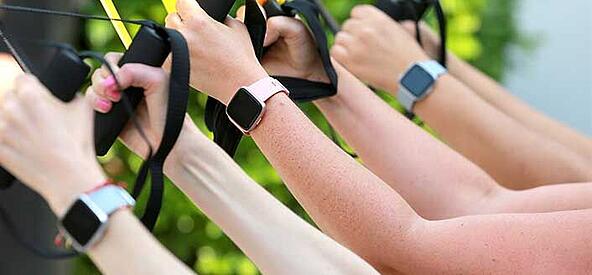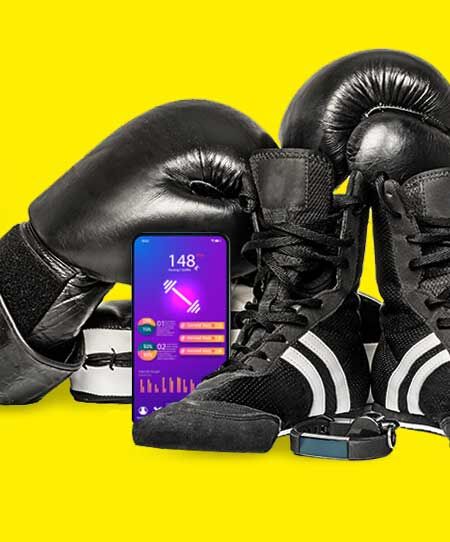The world of sports traditionally has embraced emerging technology to improve player performance, develop effective strategies, and increase fan enjoyment. Breakthroughs in nutrition and athletic conditioning have helped sculpt the human body into ideal physical shape. Sports analytics, most famously deployed in Major League Baseball, have reshaped the way scouts evaluate players. Referees have utilized instant replay to increase fairness, and high-definition scoreboards offer a wide range of information for the fans to digest. Now, with the Internet of Things (IoT), athletic organizations are exploring new methods of data analysis that will give them an edge on and off the field and optimize the fan experience on game day.
Wearables for Tracking and Improving Athletic Performance
Wearable connected devices form the basis of IoT in sports. Well-known consumer wearables, such as the Fitbit and the Apple Watch, can help athletes track vitals and performance metrics, but they only are the beginning. Clothes with embedded sensors can analyze heart rate, breathing rate, muscle oxygenation, and specific muscle usage throughout practices and scrimmages. Shoes outfitted with pressure sensors and accelerometers can show where an athlete tends to balance their weight and accurately measure their speed, stopping power, and stamina.

As more data is gathered on a players performance from these connected wearables, an IoT management platform can provide analytics on energy expenditure, form, and endurance. Armed with this information, coaches and trainers can adapt a players regimen to their specific needs from week to week, reducing the potential for injury both in training and during the games. Over a longer period of time, IoT data can give players a better understanding of their own strengths and weaknesses so that they can achieve breakthroughs and surpass their performance objectives.
Connected Equipment for Form and Accuracy
Beyond smart shoes and smart clothes, smart fitness equipment is a new way to track athlete performance in the gym and during practice, providing new sets of goals and inspiration. Connected equipment could be sport-agnostic, such as weight machines that measure lifting rates and form to maximize goal achievement, or sport-specific, such as punching bags with sensors for boxers to track punching power, speed, and accuracy. For example, sports technology company Spektacom has developed an IoT sensor for cricket bats so that coaches and players can evaluate hitting strength, bat speed, and accuracy. With data-driven metrics to motivate them every time they face a machine or pick up a bat, an athlete constantly will be inspired to meet training challenges and exceed their goals.
In ball sports, such as football and basketball, the balls themselves can be outfitted with embedded sensors to track shot accuracy, passing accuracy, and strength. These insights provide immediate benefits for both players and coaches alike. Players can evaluate their mechanics and arm strength to adjust and improve their form and ability, and coaches can develop strategies around a players performance level for optimal deployment in-game.
Optimizing the Fan Experience
While IoT has measurable benefits for improving player performance and developing team strategy, it also can be deployed to significantly enhance the fan experience. In January, AT&T announced plans to bring 5G to the Dallas Cowboys stadium. Connected stadiums powered by 5G will add a new dimension to watching games. Spectators with a stadium app can watch instant replays on their smartphones, panning the field at multiple angles to gain more insight into plays in real time. The same app also can measure concessions and restroom traffic so that fans can limit their time away from their seats. Using augmented reality, a fan can zoom in on a player to see a breakdown of their stats and current game performance.
Some IoT applications even have appeal to players and fans alike. Beyond the hitting ability metrics offered to cricket players and coaches, Spektacom also has developed what they call Power Speks, a fan portal for spectators to track player performance in real time, gaining greater appreciation for the prowess of their favorite players. For youth league players who want to emulate their heroes, Spektacoms Power Speks gives them the opportunity to study their idols up-close and learn from their playing style.
Take the Lead and Treat Your Fans with Aeris IoT
IoT is helping teams and players in every sport achieve better results on and off the field, giving fans an enjoyable, interactive experience during the game. At Aeris, we provide connectivity solutions that make these enhanced experiences possible. Aeris IoT offers customers unparalleled scalability and deployment across diverse networks anywhere in the world. Through the Aeris Connectivity Platform, managers can easily provision devices and gain understanding from device data in real time. No matter the application, Aeris IoT can deliver results.
To learn more about how IoT can give your team the competitive edge and expand your fans game day experience, contact Aeris today.



